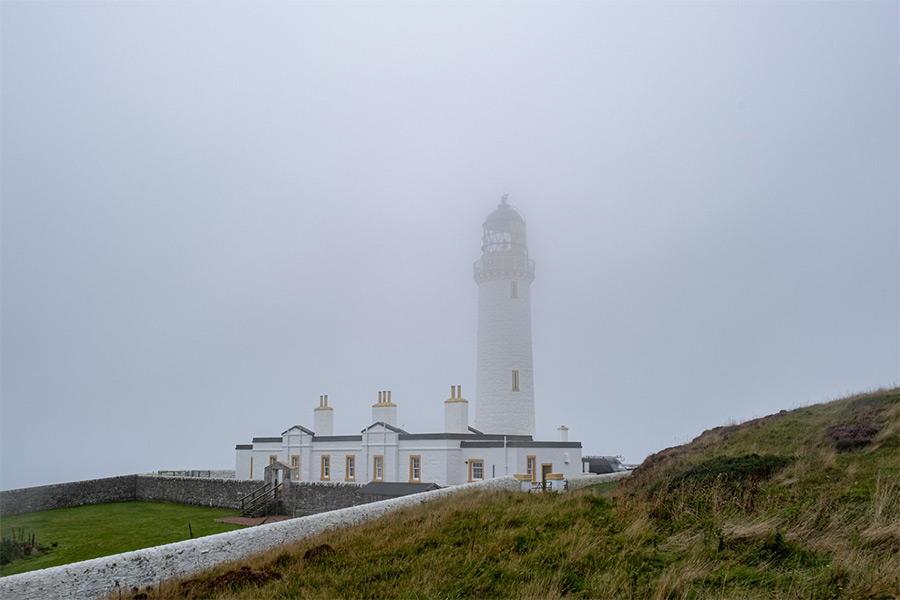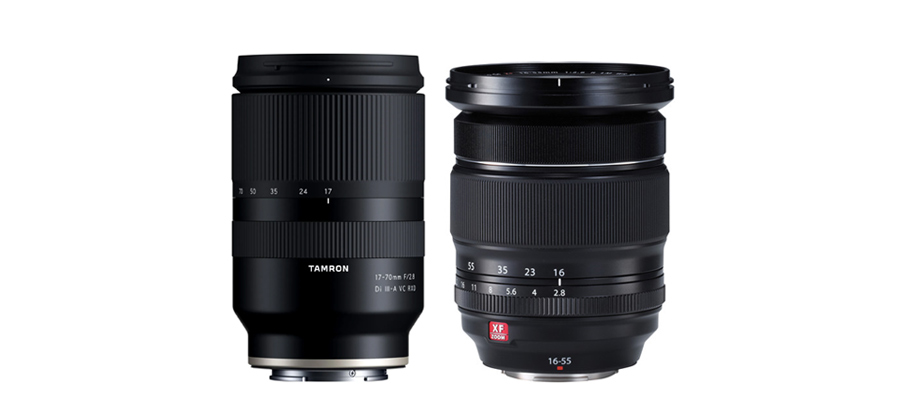The Tamron 17-70mm f/2.8 Di III-A VC RXD and Fujifilm 16-55mm f/2.8 R LM WR are both excellent all-around zoom lenses with a fixed aperture of f/2.8. Let’s see which one is better!
Tamron 17-70mm f/2.8 Di VC RXD
- Focal Length: 17-70mm
- Max Aperture: f/2.8
- Mount: Fujifilm X
- Stabilized: ✔️
- Weather-Sealing: ✔️
- Weight: 525
- Released: 2023
- Amazon ($$)
Fujifilm 16-55mm f/2.8 R LM WR
- Focal Length: 16-55mm
- Max Aperture: f/2.8
- Mount: Fujifilm X
- Stabilized: ❌
- Weather-Sealing: ✔️
- Weight: 655g
- Released: 2015
- Amazon ($$$)
The Fujifilm 16-55mm f/2.8 is almost double the price of the Tamron 17-70mm f/2.8! They are both aimed at all-around photographers who want a fast f/2.8 aperture, but there’s an 8 year release gap between them, so let’s see if the newer Tamron is that much better.
In this comparison, I will go over all of their advantages and how they compare in different photography styles.
If you’re in a hurry, the advantages below are all you need to make the final decision.
Advantages of Tamron 17-70mm f/2.8 Di III-A VC RXD
Advantages of Fujifilm XF 16-55mm f/2.8 R LM WR
Now, let’s see which features and advantages are actually important for your specific needs and which ones only sound good on paper.
Tamron 17-70mm f/2.8 vs Fujifilm 16-55mm: Detailed Comparison
🔭 1. Focal Length
- Tamron 17-70mm: From 17mm to 70mm
- Fujifilm 16-55mm: From 16mm to 55mm
- Winner: Tamron 🏆
The Fujifilm 16-55mm f/2.8 R LM WR has 1mm wider zoom, and while this gives it a slight advantage in landscape and interior photography, the Tamron 17-70mm f/2.8 features a bigger overall zoom range.
Going from 17 to 70mm in a single twist makes it much more ideal for more types of photography. From traveling, weddings, portraits and even close sports, it’s much more capable than the 16-55m focal length of the Fuji.
Don’t get me wrong, both can be used as all-around lenses, and I’ve often traveled with ~18-50mm (or 24-70mm on full-frame) without any issues at all.
If you are looking for that 1 lens to give you as much reach as possible and rarely want to carry around anything else, the Tamron is the better option.
🎥 2. Maximum Aperture
- Tamron 17-70mm: Constant maximum aperture of f/2.8 at all focal lengths
- Fujifilm 16-55mm: Constant maximum aperture of f/2.8 at all focal lengths
- Winner: Tie
Both Tamron 17-70mm f/2.8 Di III-A VC RXD and the Fujifilm 16-55mm f/2.8 R LM WR have a constant f/2.8 aperture, which is great news for shooting in low light or less than ideal lighting conditions.
You can always select a smaller aperture, but f/2.8 is also great for blurring the background. This is useful for weddings, portraits, animals and macro photography.

📏 3. Dimensions & Weight
- Tamron 17-70mm: 525g
- Fujifilm 16-55mm: 655g
- Winner: Tamron 🏆
The Tamron 17-70mm f/2.8 Di III-A VC RXD is 20% lighter (130g) than the Fujifilm 16-55mm f/2.8 R LM WR.
It may not sound like a lot, but you’ll definitely notice it when traveling with an extra lens. Even though both Fuji and Tamron were designed for APS-C systems, the 8 years newer Tamron manages to shed a lot more weight, despite its longer zoom.
- Tamron 17-70mm: 74.6×119.3mm
- Fujifilm 16-55mm: 83.3 x 106.0mm
- Winner: Fujifilm 🏆
The Fujifilm 16-55mm f/2.8 is 10% shorter in length, but they’re both pretty much the same in size. The Fuji is shorter but wider, and so the overall volume is nearly identical.
If you want an f/2.8 zoom that weighs almost half as much, check out my comparison versus the Sigma 18-50mm f/2.8 DC DN.
🎥 4. Minimum Aperture
- Tamron 17-70mm: f/16
- Fujifilm 16-55mm: f/16
- Winner: Tie
Both lenses can stop down to aperture f/16, which is acceptable but nothing special.
Personally, I almost never go smaller than f/16, especially because of diffraction which can reduce image quality. You can see more about this in my aperture tutorial.
🔬 5. Minimum Focusing Distance
- Tamron 17-70mm: 19cm at 18mm
- Fujifilm 16-55mm: 30cm at 16mm
- Winner: Tamron 🏆
The Tamron 17-70mm f/2.8 can focus on a subject that’s merely 19cm away from the camera!
Compare that to the Fujifilm 16-55mm f/2.8 that won’t focus on anything further than 30cm. It’s not bad, but for close-up photography, macro, flowers and food, it might be a bit too short sometimes.
Remember, these distances are measured from your camera’s sensor and not from the front of the lens.
⛅ 6. Weather-Sealing
- Tamron 17-70mm: ✔️
- Fujifilm 16-55mm: ✔️
- Winner: Tie
For casual use, all lenses can handle a normal amount of rain, snow and dust. They won’t dissolve when a little bit of water hits them.
Luckily, both Tamron and Fuji lenses are completely weather-sealed and ready to shoot in challenging weather situations. If you often travel and feel stressed about your gear, you’ll want a lens that is well protected.
🎦 7. Image Stabilization
- Tamron 17-70mm: ✔️
- Fujifilm 16-55mm: ❌
- Winner: Tamron 🏆
Image stabilization helps make your images appear less blurry when shooting with slow shutter speeds.
The Tamron 17-70mm f/2.8 has stabilization built-in (VC in its name stands for Vibration Reduction). This is excellent news if you’re shooting with a Fuji camera that doesn’t have any in-body stabilization.
VC/IS won’t help freeze moving subjects, it will only help correct your unwanted movement when taking a picture.
💿 8. Aperture Blades
- Tamron 17-70mm: 9 rounded diaphragm blades
- Fujifilm 16-55mm: 9 rounded diaphragm blades
- Winner: Fujifilm 🏆
Both lenses feature a 9 diaphragm aperture design, with rounded blades.
Bokeh looks smooth and overall not distracting, making them good for portrait and product photography.

📽 9. Filter Size
- Tamron 17-70mm: 67m filter size
- Fujifilm 16-55mm: 77mm filter size
- Winner: Tamron 🏆
The Tamron 17-70mm f/2.8 Di III-A VC RXD accepts 67mm filters. They’re right in the middle as far as pricing and availability goes.
For the Fujifilm 16-55mm f/2.8 R LM WR, you’ll need to buy 77mm filters. These are a lot more expensive, but still common in most photography stores.
💲 10. Price
- Tamron 17-70mm: ~$699
- Fujifilm 16-55mm: ~$1100
- Winner: Tamron 🏆
The Fujifilm 16-55mm f/2.8 costs around $400 more than the Tamron 17-70mm.
What does the higher price tag give you? 1mm wider reach and a classic Fujifilm look with an aperture ring, which the Tamron doesn’t have.
If Fujifilm is planning on announcing new lenses, I can guarantee you that an updated 16-55mm f/2.8 will be one of them. There’s too much competition out there, with better features and lower prices.
Tamron 17-70mm vs Fujifilm 16-55mm: Photography Type
From 1 being the worst, 5 being the best.
It’s best to choose a lens that suits your favorite photography types, or offers you something that your current gear is not good enough for.
Tamron 17-70mm vs Fujifilm 16-55mm: Comparison Table
Better specifications are highlighted in green.
| 🎥 Lens Specification | Tamron 17-70mm f/2.8 | Fujifilm 16-55mm f/2.8 |
|---|---|---|
| Focal Length | 17-70mm | 16-55mm |
| 35mm Equivalent | 25.5-105mm | 24-83mm |
| Mount | Fujifilm X (APS-C) | Fujifilm X (APS-C) |
| Maximum Aperture | f/2.8 | f/2.8 |
| Minimum Aperture | f/16 | f/16 |
| Filter Size | 67 mm | 77 mm |
| Maximum Magnification | 0.21x | 0.16x |
| Minimum Focus Distance | 19 cm | 30 cm |
| Aperture Ring | No | Yes |
| Focus Type | Autofocus | Autofocus |
| Motor Type | Stepper Motor | Linear Motor |
| Lens Construction | 16 elements in 12 groups | 17 elements in 12 groups |
| Aperture Blades | 9 (rounded) | 9 (rounded) |
| Image Stabilization | ✔️ | ❌ |
| Weather Sealing | ✔️ | ✔️ |
| Dimensions (mm) | 74.6 x 119.3mm | 83.3 x 106.0mm |
| Weight (g) | 525g | 655g |
| Hood Included | No | Yes |
| Released | 2023 | 2015 |
| Price | Amazon | Amazon |
So, which lens is the better one?

Choose the Tamron 17-70mm f/2.8 if:
- You want more telephoto zoom for travel/portraits/sports
- You often do macro and close-up photography
- Your camera doesn’t have built-in stabilization
- You want a 130g lighter lens
- You want to pay around $400 lens, and save on filter prices
Choose the Fujifilm 16-55mm f/2.8 if:
- You want a 1mm wider focal length
- You want an aperture ring with the usual Fuji rotation
The clear winner is Tamron 17-70mm f/2.8 Di III-A VC RXD.
It packs in way more features for way less money. Win-win!

